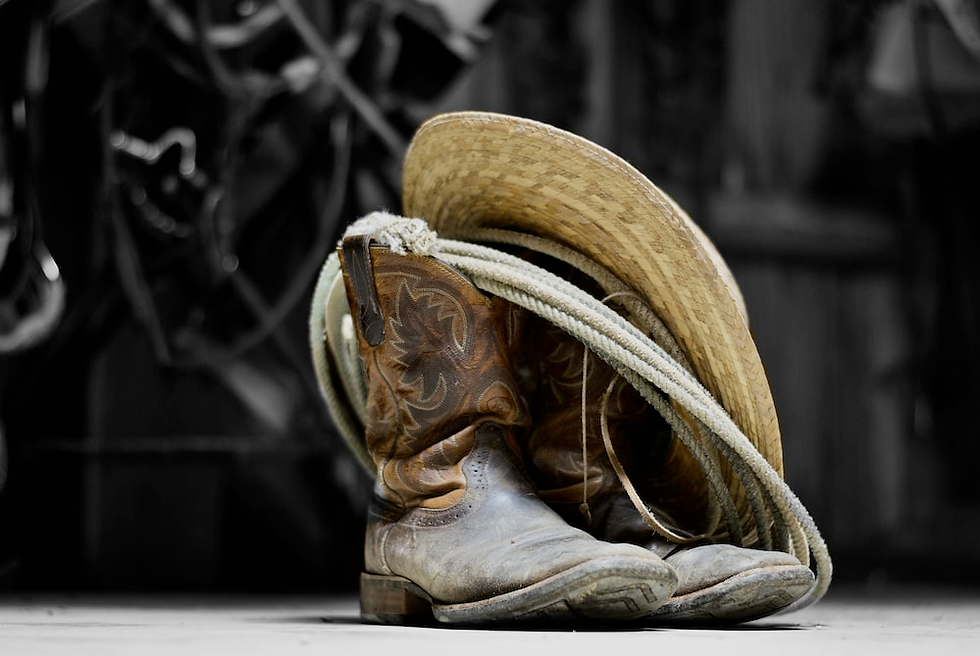Why Cowboy Boots Have Spurs: The History of Riding Boots and Their Accessories
- New Cowboy Boots
- Aug 23, 2022
- 3 min read

A cowboy’s boots are his best friend in the saddle, and they are essential riding gear that every cowboy needs. From their origins as unassuming leather boots with a few short iron spurs attached to them, modern cowboy boots have evolved into a complex accessory that is not just about keeping your feet dry or protected from thorns and other sharp objects on the ground. At once practical, stylish and even symbolic of an entire culture, a good pair of fully-equipped cowboys remains an indispensable part of any self-respecting cowboy’s outfit. With their laces, straps, buckles and spurs all indicative of their role as riding gear, cowboy boots have come a long way from simply being a protective covering for your feet. Here is everything you need to know about the history of riding boots and their accessories.
Origins of Cowboy Boots
The history of cowboy boots is a long one, dating back to the earliest days of cattle ranching in the American West. When the first Spanish explorers and settlers arrived in the New World, they brought with them a tradition of riding moccasins. This was a single-piece leather boot that was not only simple and easy to make, but incredibly comfortable to wear as well. However, moccasins were not the best option for riding horses, as they offered no protection for a cowboy’s feet. Consequently, early cowboys began to wear heavy leather boots that were specifically designed for riding horses. These early riding boots were not terribly different from regular boots, except perhaps in the durability of their construction. They came with a single spur attached to the heel of the boot, and were worn regularly by cowboys.
What is a Spur?
A spur is a sharp metal device that is attached to the heel of a riding boot. It is used to spur a horse into action or to make it gallop quickly, or to stop it suddenly. Spurs may also be used to inflict pain on an animal, such as a rodeo bull or a wild horse, to keep it under control. Spurs are usually made from iron. Early spurs were primitive devices made of iron spikes attached to the heel of a boot with a piece of leather. As time progressed, spurs began to be manufactured from a wide range of materials, including wood, copper, brass, silver and even diamonds. Today, spurs are essential riding gear for any cowboy, and come in a wide range of styles, materials and designs.
The Importance of Tying and Lacing
Like any riding boot, a quality pair of cowboys will be made from a sturdy, durable material, such as leather. However, unlike regular boots, riding boots will also have a snug fit and strong lace-up closure that goes up past the ankle to ensure that the foot stays firmly in place while the rest of the body is in motion. Riding boots come with additional leather straps that can be tightened to keep the foot in place. Some boots have an additional strap that is wrapped around the ankle for extra support. Riding boots also come with a spur strap that can be tightened to keep the spur in place.
Zippers and Buttons
While traditionally made from leather, modern cowboy boots also come in a wide range of other materials and designs. From suede to synthetic materials, and even with different types of soles, cowboy boots are available in an array of colours and designs. While classic leather boots will always remain a timeless item, other materials, such as synthetic fabrics, are designed to be lightweight and easy to clean. Cowboy boots with a zipper can be taken off and put on quickly, while those with buttons are more stylish, albeit less convenient.
Decorations and Features
A good pair of cowboy boots will provide both comfort and durability, but they need not be boring and plain. Every high-quality pair of boots will come with decorative stitching and/or a bold design, as well as metal eyelets, metal grommets and other features that make them unique. Cowboy boots come with a wide range of decorative features, and you can choose the ones that suit your personality and preferences best. Some boots feature metal plates and buckles, whereas others come with decorative stitching and patterns.
Conclusion
The history of cowboy boots is an interesting one, and a study of their history reveals that they have come a long way from those simple leather boots made for riding horses. Today, there are multiple types of riding boots available, each with a specific design and purpose. With their laces, straps, buckles and spurs all indicative of their role as riding gear, cowboy boots have come a long way from simply being a protective covering for your feet. With their wide range of materials, designs and decorative features, they are not only functional but are symbols of an entire culture.





Comments